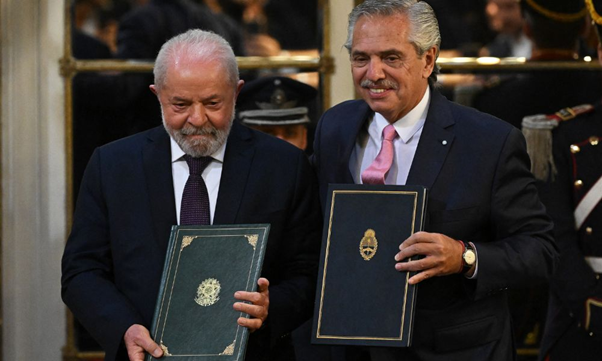
Lula da Silva is back in the Brazilian presidency and with him so does the dream of a strong and economically independent Latin America. The newly elected president flew to Buenos Aires for his first official international trip to discuss with the country’s leader Alberto Fernandez the future of Brazil and Argentina’s economic cooperation. On the table is the creation of a new economic zone with its currency, The Sur.
The strategic alliance, announced in an article co-written by both leaders, aims to strengthen democracy and increase economic independence from the dollar. They wrote:
"Our intention is to overcome the barriers to trade between our countries, simplify and modernize rules and increase the use of local currencies. We also decided to advance talks on a south-American common currency to be used for financial and commercial flows, reducing the cost of operations and our external vulnerability.”
Political pains of Brazil and Economic pains of Argentina
Neither the Argentine peso nor the Brazilian real are strong enough currencies to be used in international trade. As such, the countries have to resort to the dollar for external transactions.
Under the presidency of Jair Bolsonaro in Brazil, bilateral relations were tense. But Lula Da Silva, who in previous mandates was a strong advocate for increasing economic and political regional integration, is determined to strengthen ties with Brazil’s biggest trading partner.
The dependency on the dollar has been a cause of great economic affliction in the region. The 1980s, also called “The Lost Decade”, were a period of major setbacks in the continent’s development levels as a profound crisis led millions into poverty. The spike in oil prices led developed countries to increase interest rates, raising the price of Latin American countries debts. Because the debts were nominated in dollars, the nations were powerless and had to submit to economic impositions set by the IMF.
The economic sanctions imposed on Russia by developed countries after the conflict with Ukraine brought back the memory of those days. In an article published last year by the current Brazilian finance minister Fernando Haddad and his executive secretary, Gabriel Galiplo, they proposed a new currency strong enough to be used as an international means of payment, hence increasing the sovereignty of the countries involved and diminishing exposure to the volatility of international financial markets.
On the other side of the border, Argentina’s foreign reserves have been under great pressure, after the country’s exclusion from international markets for defaulting in 2020. Inflation almost doubled last year, making living conditions increasingly harsh as people juggle between 20 different exchange rates to pay for essential goods. One of Argentina´s most important monetary seminars called “el fin de la inflácion” (the end of inflation), had the scenario of a common currency as a possible solution to that country´s long-lasting inflation. For Federico Sturzzenegger, one of the economists presenting at the seminar, its realization is preferable to pairing the peso with the dollar.
So, in the beginning of 2023, the idea became an official project. Although the project will kick off as an Argentina-Brazill affair, Sergio Massa, Argentina’s economy minister, told Financial Times that “It is Argentina and Brazil inviting the rest of the region,”. In Buenos Aires, the announcement was made a few hours before a CELAC (Community of Latin American and Caribbean States) meeting in which other Latin American leaders were present, such as president Gustavo Petro from Colombian and Chile's Gabriel Boric. According to FT, an economic zone encompassing all countries of the region would represent 5% of global GDP, second only to the European Union which currently accounts for 11%.
The Sur is a Common Currency, not a Single Currency
With nationalism flying high in Brazil and considering Argentine’s Central Bank’s uncontrolled monetary expansions, presidents felt the need to explicitly write in the memorandum signed by the two countries that the new currency won’t replace the real or peso. Instead, it will work as a means of payment for financial and commercial payments. It will work as a liquidity pool - Brazilian buyers will perform a transaction in reais that will be converted into “Surs” and again into pesos, which an Argentina seller will be able to access, or vice-versa.
From the technical viewpoint, the above design is close to so-called wholesale cross-border central bank digital currencies (CBDCs). Both Brazil and Argentina are exploring the use of CBDC and are making progress in this area. The Central Bank of Brazil aims to launch a CBDC by 2024, while Argentina has established a National Blockchain Committee to expedite the process. The advantage of CBDCs over regular electronic money is that, in some designs, its parameters can be programmed cryptographically, which makes it independent of political pressures.
Quick to react to the news was Brian Armstrong, the CEO of Coinbase, who proposed to use Bitcoin for that purpose. Critics of Armstrong's suggestion argue that the volatility of Bitcoin makes it difficult to use in day-to-day transactions and is not suitable as a national currency. Raoul Pal, a well-known Bitcoin critic stated that "currently no one can have a national currency with 100% volatility that declines 65% in the down part of the business cycle and rises 10x in the upcycle."
The Perspectives for Digital Sur
As both countries are plagued with political and economic instability, leading even the most promising cooperation initiatives like Mercosur to stall, any implementation of "The Sur’", let alone a digital one, is far from probable. Nevertheless, the "courage" of other Latin American countries leaves us some hope for a breakthrough, we charged ourselves with a duty to observe this development too.
